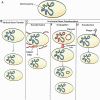Beyond the pan-genome: current perspectives on the functional and practical outcomes of the distributed genome hypothesis
- PMID: 33245329
- PMCID: PMC7752077
- DOI: 10.1042/BST20190713
Beyond the pan-genome: current perspectives on the functional and practical outcomes of the distributed genome hypothesis
Abstract
The principle of monoclonality with regard to bacterial infections was considered immutable prior to 30 years ago. This view, espoused by Koch for acute infections, has proven inadequate regarding chronic infections as persistence requires multiple forms of heterogeneity among the bacterial population. This understanding of bacterial plurality emerged from a synthesis of what-were-then novel technologies in molecular biology and imaging science. These technologies demonstrated that bacteria have complex life cycles, polymicrobial ecologies, and evolve in situ via the horizontal exchange of genic characters. Thus, there is an ongoing generation of diversity during infection that results in far more highly complex microbial communities than previously envisioned. This perspective is based on the fundamental tenet that the bacteria within an infecting population display genotypic diversity, including gene possession differences, which result from horizontal gene transfer mechanisms including transformation, conjugation, and transduction. This understanding is embodied in the concepts of the supragenome/pan-genome and the distributed genome hypothesis (DGH). These paradigms have fostered multiple researches in diverse areas of bacterial ecology including host-bacterial interactions covering the gamut of symbiotic relationships including mutualism, commensalism, and parasitism. With regard to the human host, within each of these symbiotic relationships all bacterial species possess attributes that contribute to colonization and persistence; those species/strains that are pathogenic also encode traits for invasion and metastases. Herein we provide an update on our understanding of bacterial plurality and discuss potential applications in diagnostics, therapeutics, and vaccinology based on perspectives provided by the DGH with regard to the evolution of pathogenicity.
Keywords: bacterial pathogenesis; comparative genomics; pan-genome.
© 2020 The Author(s).
Conflict of interest statement
The authors declare no competing interests
Figures


References
-
- Smith-Vaughan H.C., Sriprakash K.S., Mathews J.D. and Kemp D.J. (1997) Nonencapsulated Haemophilus influenzae in Aboriginal infants with otitis media: prolonged carriage of P2 porin variants and evidence for horizontal P2 gene transfer. Infect. Immun. 65, 1468–1474 10.1128/IAI.65.4.1468-1474.1997 - DOI - PMC - PubMed
Publication types
MeSH terms
Grants and funding
LinkOut - more resources
Full Text Sources

